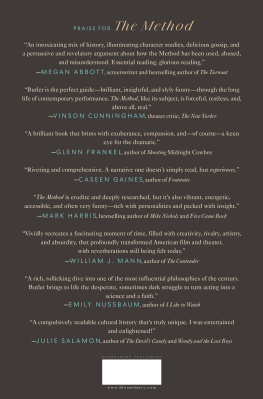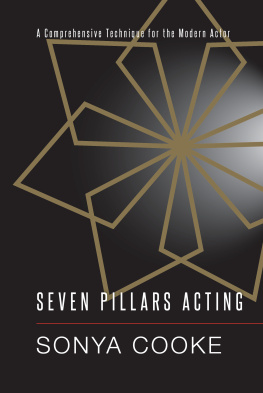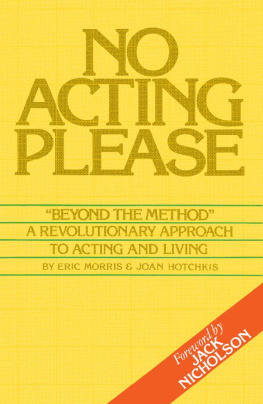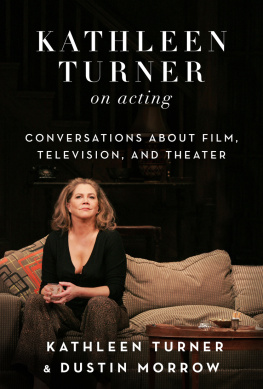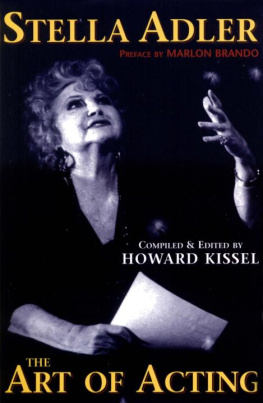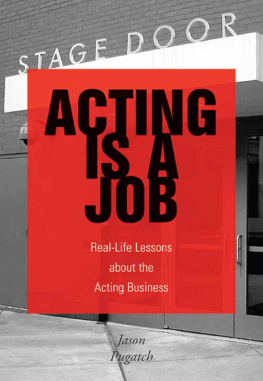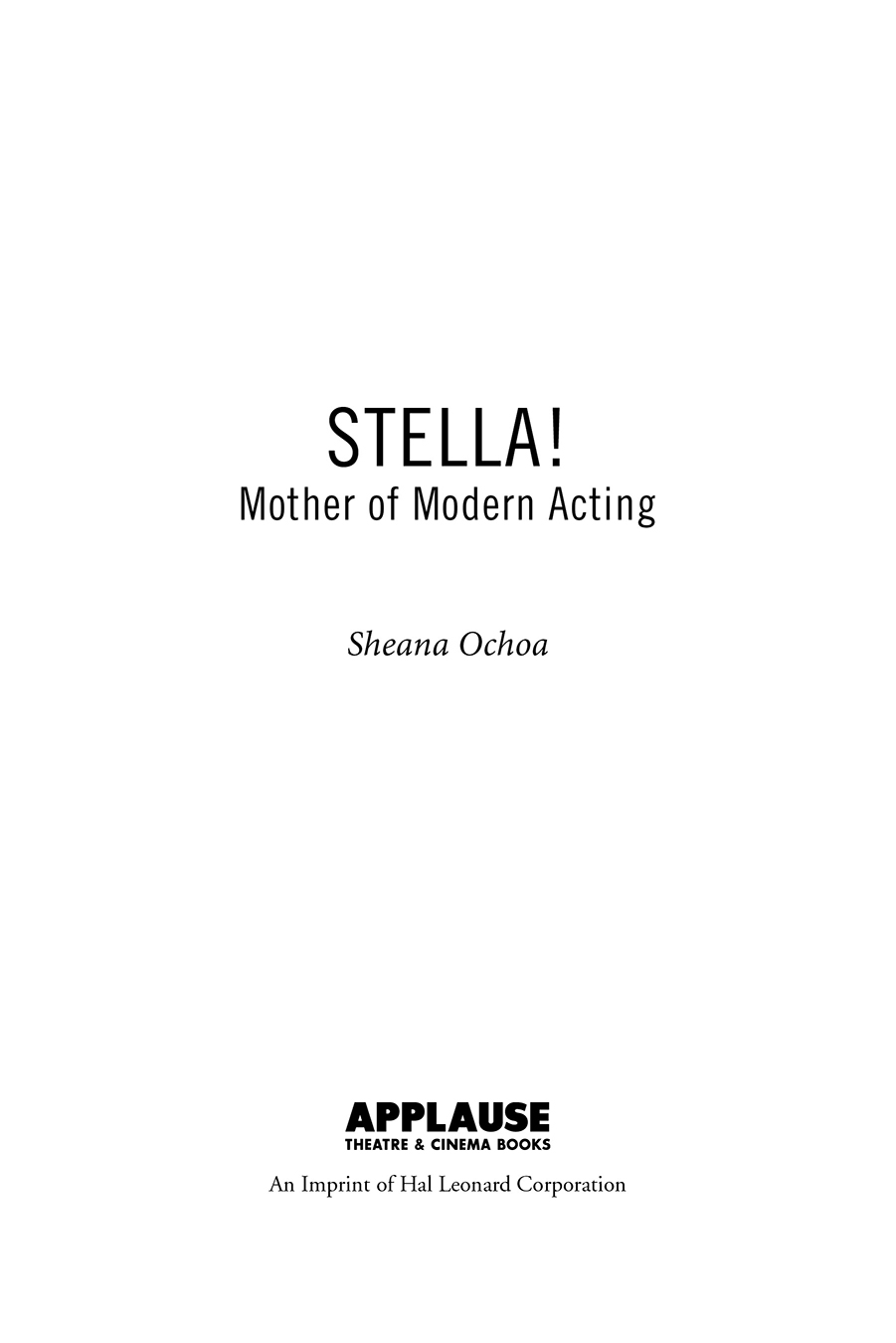Copyright 2014 by Sheana Ochoa
All rights reserved. No part of this book may be reproduced in any form, without written permission, except by a newspaper or magazine reviewer who wishes to quote brief passages in connection with a review.
Published in 2014 by Applause Theatre & Cinema Books
An Imprint of Hal Leonard Corporation
7777 West Bluemound Road
Milwaukee, WI 53213
Trade Book Division Editorial Offices
33 Plymouth St., Montclair, NJ 07042
Printed in the United States of America
Book design by Kristina Rolander
Library of Congress Cataloging-in-Publication Data
Ochoa, Sheana.
Stella! : mother of modern acting / Sheana Ochoa.
pages cm
Includes bibliographical references and index.
ISBN 978-1-4803-5553-8 (hardcover)
1. Adler, Stella. 2. Acting teachers--United States--Biography. 3. Method acting. I. Title.
PN2287.A433O34 2014
792.02'8092--dc23
2014003395
www.applausebooks.com
To Irene Gilbert, whose contagious commitment
to Stella Adlers legacy inspired this book
Contents
I was eighteen years old when I first encountered Stella Adler. I had decided to become an actor and took the train daily from San Diego, where I lived with my parents, to the Stella Adler Conservatory of Acting in Los Angeles. I didnt have the money to pay for school, so I was put in a work-study program. One of my many jobs was to assist Stella from her car to her dressing room, where she would prepare for her classes.
I had read her book The Technique of Acting and carried it around with me in a backpack that contained virtually everything I owned at the time. I took the liberty of asking her to sign it for me. In it she inscribed, The young actor wants to give back to the world some of the greatness he finds in himself.
Stella Adler wanted us to find some of that greatness and make us capable of imparting it to the world. One always had the sense that when she looked at you she was scanning you for the depth of your greatness and would accept nothing less. She would not stand for the diminishing of ones self in any way. Nor would she accept any excuses that barred one from being exemplary. She refused to allow race, class, religion, intelligence, or anything else one might use as a crutch or excuse for being anything other than better than what one was.
I can still remember Stellas voice cutting through the dark theater where we all sat in attendance straight-backed and wide-eyed, half out of deference and half out of fear: You must be better then what you are! You must build yourselves, your bodies, your voices, your minds, because you are part of a two-thousand-year-old tradition! You are an actor and therefore you are an artist, and because you are an artist you have an obligation and responsibility to make yourself better! You are American aristocracy! Stellas demand that one better oneself was really at the root of what she and her teaching were about. In that vein she went to the Soviet Union in 1934 to study the Moscow Art Theater; that same year she became the only American teacher to work with Stanislavski to gain a deeper and more articulated understanding of his method.
Although ultimately what she was after was an honest, naturalistic style of acting, her love of the big ideas of the playwrights and her keen sense of social justice drove that naturalism toward nobility. She was always worried that the naturalistic style would lead an actor to believe that he or she could drag the material down to the humdrum personalities of stars while missing the greater and deeper ideas of the plays. She would often quote George Bernard Shaw: You should have to pay to go to church and the theater should be free. For her, the theater was where we really learned about mankind and how we were supposed to be in the world.
An actor is as significant a part of the culture or society as any priest or spiritual teacher, and therefore the actor is of service to something much greater than him- or herself. Stella Adler understood how transformational theater and film could be and held acting in the highest regard as a vehicle for the transcendent power of the written word. The actors job is to ensure that the words of the great writers echo out into the ethos of our time.
Her high ideals and devotion to the greatest and most noble assertion of her acting technique made Stella Adler one of the most influential acting teachers and theater personalities of modern times.
Its been a long days journey from the day Ms. Adler signed my copy of her acting book. I still look for that greatness within myself. I still see where I can improve. I still believe that my chosen profession is a significant art form and that the artist must be an agent of change in the evolution of humanity. I hope that this book illuminates her journey and reveals her purely original life and devotion to her craft to another generation of actors.
Mark Ruffalo
New York, 2013
I want to thank the first teacher who imparted the inestimable art of storytelling to her students, Gwyn Erwin, with whom I began working on this book many years ago. Biographies are a difficult genre in that it may take weeks, months, even years to obtain or discover materials. I want to acknowledge all the librarians who helped me to find and gather materials. In particular I want to thank Jeremy Megraw of the New York Public Library of the Performing Arts, Billy Rose Theatre Division, not only for his expertise, but also for his ongoing support in the form of sending speedy replies to inquiries, finding materials I needed to unearth again, helping with rights and permissions, and being an all-around pleasant person. Helen Baer at the University of Texas in Austin, which holds the bulk of Stellas papers, has also been an invaluable and reliable resource; she facilitated my efforts with licensing and permissions from both written materials and photographs. I have to give special thanks to Robert Ellerman for challenging any assumptions I may have made and lending me the invaluable materials listed in my notes on the sources.
It has been a long journey, and along the way I was wise enough to seek professional consultants for the books proposal, which helped the books structure and encouraged me to keep working. I thank Dorothy Wall and Marcela Landres for their expertise. There were those uncompensated readerswriters and friendswho helped shape the book. I am grateful to the critical feedbacknot always what I wanted to hear, but what I needed to hearfrom Deborah Martinson, Patrick Scott, Leo Braudy, Charles Waxberg, and Cyntia Taylor. Then there were my sisters-in-arms who may have read the book or given me that much more valuable gift that every artist who finds herself stumbling in the dark from time to time needs in order to make it back out into the light. These were my cheerleaders who nurtured me spiritually. From the bottom of my heart, thank you, Mary Gulivindala, Beth Philips, Lara Anderson and Rue Drew, for your radiant beauty and encouragement. I would also like to give thanks to Stellas grandniece Allison Adler and her granddaughter, Sara Oppenheim, who seemed to understand that I did not have any particular agenda besides telling the story of Stellas life for posterity. It was invaluable to have their support throughout the years. I want to thank my familymy beloved son, Noah, and especially my husband, Jordan Elgrably, who entered my life during the books home stretch and who has been supportive, patient, and compassionate through the peaks and valleys of bringing it to publication. Speaking of publication, thank you, John Cerullo and the family at Applause, for guiding me through to publishing Stella! with professionalism, open-mindedness, and support. Lastly, I could but perhaps would not have written this book without my parents unflagging support of me. They fostered my belief that I could be and do whatever I set my mind tothe greatest gift a child can be given.



